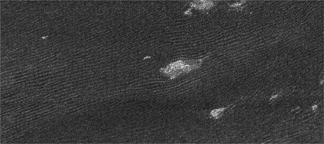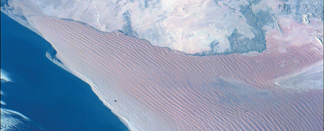|
News Notes
Planetary geology
Dunes on Titan
 |
| Sand dunes discovered on Saturn’s moon Titan (above) are structurally similar to dunes in Earth’s Namib desert in southern Africa (below). The dunes’ various orientations are helping astronomers map Titan’s wind patterns. Image above is courtesy of NASA/JPL. Image below is courtesy of NASA. |
 |
To some degree, Saturn’s moon Titan, with its low gravity, thick atmosphere and exotic surface composition, hardly resembles Earth. Despite such differences, however, new images from NASA’s Cassini spacecraft are revealing that some physical surface processes behave in much the same way on both Titan and Earth. The new images show regions of Titan with vast systems of 100-meter-tall linear dunes, similar in shape and size to formations seen in Earth’s Namib and Sahara deserts, and are helping researchers understand Titan’s wind patterns.
Some astronomers once thought that the dark regions seen in initial Titan images were possible sites of liquid methane oceans. But radar images of Titan returned from the Cassini orbiter on Oct. 27 revealed that instead of methane oceans, some of the dark spots are actually dunes, according to Ralph Lorenz, an astronomer at the University of Arizona in Tucson. The discovery rules out the possibility of surface liquid at dune locations — as in the arid deserts on Earth, liquid would prevent dune movement and growth.
Dune systems cover 65 percent of the October flyby’s imaged path, with some systems spanning areas 1,500 kilometers by 200 kilometers, says Lorenz, who, with colleagues, published the details in the May 5 Science. The structures form from sand-sized grains, but instead of Earth-like sand, Titan’s grains are possibly composed of ice or organic materials. Despite differences in composition from Earth dunes, “the morphological result is the same,” Lorenz says.
Beyond studying dune characteristics, Lorenz used the dunes to map Titan’s winds. Surface winds on Earth derive much of their energy from the sun, and astronomers once thought Titan orbited too far from the sun to maintain surface winds strong enough to sculpt dunes. But it turns out that gravitational tugs from nearby moons and planets do the trick. Saturn’s pull on Titan creates winds strong enough to sculpt the observed features, Lorenz says. Also, the various orientations of Titan’s dunes, which stretch lengthwise in the same direction as the wind, indicate that surface winds are shifty. Such information helps provide the “big picture” of a “really interesting place,” he says.
Lorenz says that he will not be surprised if future Cassini flybys turn up more dune patches on other parts of the moon. In the meantime, he says, astronomers are considering ways to take a closer look at Titan’s dunes and other surface features by means of an airship or altitude-controlled balloon.
Kathryn Hansen

 Subscribe
Subscribe

